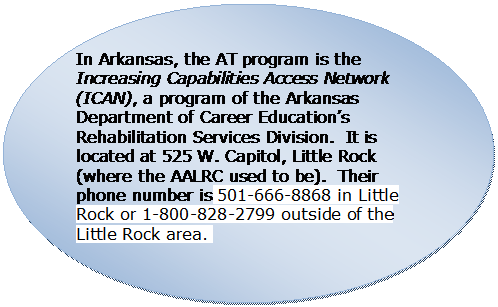
Administrators and Teachers
Resources for Adults with Learning Disabilities
Table Of Content
What is AT?
What is AT?
AT is any item, piece of equipment, or system, whether acquired commercially, modified or customized, that is commonly used to increase, maintain or improve functional capabilities of individuals with disabilities (Assistive Technology Act of 2004. P.L. 108-364). AT gives students with disabilities tools to promote independence across all areas of daily living. These common tools extend from low-tech, low-cost items to high-tech, more expensive devices. Overall, it is technology used by individuals with disabilities in order to perform functions that might otherwise be difficult or impossible.
How can AT help adults with learning disabilities?
AT can help your students with learning disabilities be more independent at work, school, and home. The chart below is not a complete listing, but it can be a good place to start when looking for AT solutions.
|
LD Characteristic |
Possible AT Applications |
| Difficulty reading | Text-to-speech software |
| Difficulty writing | Speech-to-text software |
| Difficulty being organized | Electronic/or Graphic Organizer software |
| Difficulty with math | Talking calculator |
| Difficulty with social skills | Apps |
How to find the right AT?
The first place is start is the AALRC library, which has a diverse and comprehensive assortment of AT devices. These items may be checked out for students in adult education and literacy programs in Arkansas by local program staff. Each item is available for 30 days; longer, if there are no other requests for the same item after the 30-day period.
For a list of the AT available from the AALRC, including recommendations for which learning problems may be addressed by the item, go to this pdf.
Another way to find AT is to look online. Following is a list of websites designed to help you and/or your students choose the AT that is right for their needs. The lists include software, hardware, and apps for cell phones and tablets.
- http://www.ldonline.org, an online newsletter with information for and about people with LD, including information about AT.
- http://gatfl.org/favorite-search.php, an online database that consists of hundreds of apps that have been used and tested by assistive technology professionals for many people with multiple disabilities. It has an easy-to-use search feature so an individual can search by area of need, such as organization, reading, writing, etc.
See In-Person Demonstrations of AT Products for Yourself!
AT programs show people with disabilities how to get and use AT. There is one located in every state and territory in the United States. To find the one in any state, go to http://www.resnaprojects.org/allcontacts/statewidecontacts.html

AT Programs have AT Specialists who work with you on possible solutions. They also have an AT loan program where your student can try a device or software at work, school, or home to see if it works for them before they buy one! They also have an extensive number of used items for sale at deeply discounted prices. You can see these items on ICAN’s website at http://www.ar-ican.org/equipment.html
Software features may include:
• Speech-to-text
• word completion
• word prediction
• grammar check
• spell check
• highlighting features
• study features
• color overlay
• text-to-speech
More Resources for AT
- The Alliance for Technology Access (ATA) mission is to increase the use of technology by people with disabilities and functional limitations. The ATA encourages and facilitates the empowerment of people with disabilities to participate fully in their communities.http://www.icdri.org/community/ata.htm
- The Institute for Human-Centered Design is an international, non-governmental educational organization committed to advancing the role of design in expanding opportunity and enhancing experience for people of all ages and abilities through excellence in human-centered or universal design. http://www.humancentereddesign.org/index.php?option=Home
- Assitive Technology Basics, a component of the Understood website, has a lot of information about what AT is, how to choose/use it, examples of AT, and much more. https://www.understood.org/en/school-learning/assistive-technology/assistive-technologies-basics
- enablemart is an online vendor for assistive technology devices. https://www.enablemart.com/
- Tools for Life has a list of their favorite 18 apps for people with learning disabilities at http://ldaamerica.org/tools-for-life/